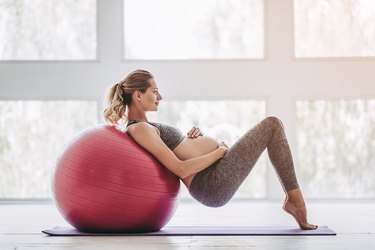
According to the American Pregnancy Association, there are many factors that contribute to discomfort and pain during pregnancy. The increasing abdomen, hormones and changing posture may create stress to your joints. Supportive devices, proper sleeping positions and exercise may help during pregnancy and with hip pain after childbirth.
Hip Anatomy and Pregnancy
Video of the Day
Your hip is a ball-and-socket joint. The ball is at the end of the femur, or thigh bone, and the socket is part of the pelvis. Your pelvis attaches to the sacrum or tailbone, which is the base of your spine. Your hip is able to flex, extend, rotate, abduct and adduct. It is also involved in accessory motions such as bending over and standing upright.
Video of the Day
During pregnancy your pelvis adjusts to allow your baby room to grow. During delivery the pelvis spreads, creating room for passage. The joints of the hip may become dysfunctional due to stiffness or even too much mobility during and after pregnancy due to this movement.
The joints of the hip are your sacroiliac, or SI joint, which is where the tailbone meets the pelvis; the pubic symphysis, where your pelvis meets in front; and the actual hip joint.
Soft-Tissue Shortening
According to Women's Health Care Topics, hormones that are produced during pregnancy that allow the muscles and ligaments to stretch, may also create stress to these soft tissues. While some muscles relax, others tighten, creating postural changes and muscle soreness. Stretches will decrease the muscular tightness, allowing a return to normal posture. Yoga and Pilates can also help relieve hip or back pain during pregnancy.
Hip Exercises for Pregnancy
Hip exercises for pregnancy can improve flexibility and relieve pain. Gentle stretches should include the hamstrings, piriformis and gluteal and quadriceps muscles. The piriformis is often a culprit in restricted him movement which illicit pain. An easy and effective piriformis stretch includes lying on your back with your right knee bent, and your left foot resting on that knee.
Lift your right leg off the ground bringing it toward your chest. Use your hands to increase this stretch, but stop if you feel pain. Hold each stretch for 20 to 30 seconds and repeat three times on each side.
Read more: Stretches for Hip Pain During Pregnancy
Core-Strengthening Exercises
Your core is your trunk strength. Weakness during pregnancy can increase pain in your hip by decreasing proper bio-mechanical function and support. The pelvic tilt and lift exercise is a basic exercise that you can begin with. Lying on your back with your knees bent, flatten your back to the floor, rocking your pelvis back. Hold for three to five seconds and release.
Precautions and Considerations
If your pain does not decrease, seek the advice and assistance of a medical professional in normalizing your joint and muscular function. Less commonly, postpartum hip pain can be due to a serious bone issue such as a fracture or osteoporosis.
According to a study published in 2015 by Nobel Medicus, hip pain after pregnancy that continues for more than one month postpartum warrants a medical examination of the lower back and hip.